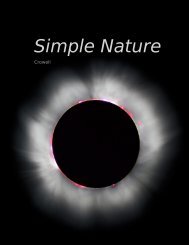The size of a radio antenna is closely related to ... - Light and Matter
The size of a radio antenna is closely related to ... - Light and Matter
The size of a radio antenna is closely related to ... - Light and Matter
Create successful ePaper yourself
Turn your PDF publications into a flip-book with our unique Google optimized e-Paper software.
⊲ Looking up the speed <strong>of</strong> light in the back <strong>of</strong> the book, v = 3.0 ×<br />
10 8 m/s, we find<br />
1 − u v = 0.99999983 ,<br />
x / <strong>The</strong> galaxy M100 in the<br />
constellation Coma Berenices.<br />
Under higher magnification, the<br />
milky clouds reveal themselves <strong>to</strong><br />
be composed <strong>of</strong> trillions <strong>of</strong> stars.<br />
y / <strong>The</strong> telescope at Mount<br />
Wilson used by Hubble.<br />
i.e., the percentage shift <strong>is</strong> only 0.000017%.<br />
<strong>The</strong> second example shows that under ordinary earthbound circumstances,<br />
Doppler shifts <strong>of</strong> light are negligible because ordinary<br />
things go so much slower than the speed <strong>of</strong> light. It’s a different<br />
s<strong>to</strong>ry, however, when it comes <strong>to</strong> stars <strong>and</strong> galaxies, <strong>and</strong> th<strong>is</strong> leads<br />
us <strong>to</strong> a s<strong>to</strong>ry that has pr<strong>of</strong>ound implications for our underst<strong>and</strong>ing<br />
<strong>of</strong> the origin <strong>of</strong> the universe.<br />
<strong>The</strong> Big Bang<br />
As soon as astronomers began looking at the sky through telescopes,<br />
they began noticing certain objects that looked like clouds<br />
in deep space. <strong>The</strong> fact that they looked the same night after night<br />
meant that they were beyond the earth’s atmosphere. Not knowing<br />
what they really were, but wanting <strong>to</strong> sound <strong>of</strong>ficial, they called<br />
them “nebulae,” a Latin word meaning “clouds” but sounding more<br />
impressive. In the early 20th century, astronomers realized that although<br />
some really were clouds <strong>of</strong> gas (e.g., the middle “star” <strong>of</strong><br />
Orion’s sword, which <strong>is</strong> v<strong>is</strong>ibly fuzzy even <strong>to</strong> the naked eye when<br />
conditions are good), others were what we now call galaxies: virtual<br />
<strong>is</strong>l<strong>and</strong> universes cons<strong>is</strong>ting <strong>of</strong> trillions <strong>of</strong> stars (for example the Andromeda<br />
Galaxy, which <strong>is</strong> v<strong>is</strong>ible as a fuzzy patch through binoculars).<br />
Three hundred years after Galileo had resolved the Milky<br />
Way in<strong>to</strong> individual stars through h<strong>is</strong> telescope, astronomers realized<br />
that the universe <strong>is</strong> made <strong>of</strong> galaxies <strong>of</strong> stars, <strong>and</strong> the Milky<br />
Way <strong>is</strong> simply the v<strong>is</strong>ible part <strong>of</strong> the flat d<strong>is</strong>k <strong>of</strong> our own galaxy,<br />
seen from inside.<br />
Th<strong>is</strong> opened up the scientific study <strong>of</strong> cosmology, the structure<br />
<strong>and</strong> h<strong>is</strong><strong>to</strong>ry <strong>of</strong> the universe as a whole, a field that had not been<br />
seriously attacked since the days <strong>of</strong> New<strong>to</strong>n. New<strong>to</strong>n had realized<br />
that if gravity was always attractive, never repulsive, the universe<br />
would have a tendency <strong>to</strong> collapse. H<strong>is</strong> solution <strong>to</strong> the problem was<br />
<strong>to</strong> posit a universe that was infinite <strong>and</strong> uniformly populated with<br />
matter, so that it would have no geometrical center. <strong>The</strong> gravitational<br />
forces in such a universe would always tend <strong>to</strong> cancel out by<br />
symmetry, so there would be no collapse. By the 20th century, the<br />
belief in an unchanging <strong>and</strong> infinite universe had become conventional<br />
w<strong>is</strong>dom in science, partly as a reaction against the time that<br />
had been wasted trying <strong>to</strong> find explanations <strong>of</strong> ancient geological<br />
phenomena based on catastrophes suggested by biblical events like<br />
Noah’s flood.<br />
In the 1920’s astronomer Edwin Hubble began studying the<br />
Doppler shifts <strong>of</strong> the light emitted by galaxies. A former college<br />
356 Chapter 6 Waves














